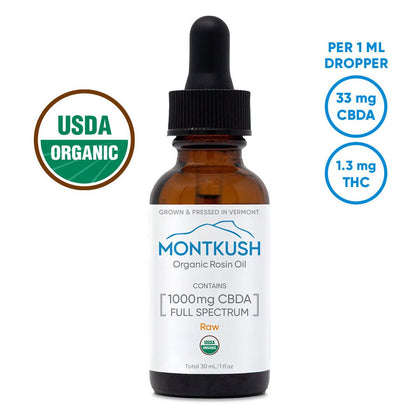

What is CBDa and How Does CBDa Work?

Cannabidiolic Acid, commonly referred to as CBDa, is a naturally occurring cannabinoid found in the raw cannabis plant. Unlike THC, which is psychoactive, CBDa does not get you high, making it a desirable option for those seeking the therapeutic benefits of cannabis without the intoxication. CBDa is most abundant in the raw version of the cannabis plant, existing in the form of cannabinoid acids until subjected to heat or sunlight.
CBDa is primarily found in the raw cannabis flower and hemp plant. This cannabinoid acid is the precursor to CBD, existing abundantly in raw hemp before it's processed into the familiar forms of CBD oil and related products.
Essentially, CBDa is the raw version of the CBD molecule, and it remains in its acidic form until decarboxylation transforms it into CBD. Studies have shown CBDa has unique properties distinct from its more well-known counterparts.
The cannabis plant is a rich source of various cannabinoid acids, including CBDa, THCa, and CBGa. When consumed in its raw form, like in raw cannabis or hemp extracts, CBDa interacts with the endocannabinoid system differently than CBD. This interaction can benefit individuals looking to explore the full spectrum of cannabinoids.
Studies suggest that CBDa may offer a unique array of therapeutic benefits that are still being explored through ongoing research.
CBDa vs. CBD - What's the Difference?

While both CBDa and CBD are popular cannabinoid compounds, they have distinct differences in molecular structure and physiological effects. CBDa is the acidic precursor to CBD, which means it exists in its raw form in the cannabis plant. In contrast, CBD is formed when CBDa undergoes decarboxylation. This difference in structure impacts how each interacts with the body's endocannabinoid system and cannabinoid receptors.
CBDa is unique in that it doesn't cause intoxication, unlike THC. This non-intoxicating nature is why many people are drawn to CBDa products. CBDa interacts with the body's endocannabinoid system differently than CBD does.
Studies have shown that CBDa interacts with specific cannabinoid receptors, offering potential benefits distinct from CBD's. For instance, research suggests that CBDa may be particularly effective in modulating serotonin receptors, which could help alleviate conditions like anxiety and nausea. Another unique aspect of CBDa is its impact on COX-2 enzymes, which play a role in inflammation and pain. By inhibiting these enzymes, CBDa has shown promise in reducing inflammatory conditions.
Both CBD and CBDa have unique benefits and can be more effective than each other for different purposes. Understanding how CBDa interacts with the endocannabinoid system helps to highlight its unique benefits and why it might be preferred over other cannabinoids for specific health conditions. This growing body of research continues to uncover the vast potential of CBDa in health and wellness.
What are the Potential Benefits of CBDa?
Okay, we've talked a bit about the science of how CBDA works. But what does it do when you ingest it? The short answer is that we know a lot less about the effects of CBDA compared to the effects of CBD. Research into CBDa is still in its early stages, but preliminary findings are promising. CBDa has shown potential therapeutic benefits, particularly its anti-inflammatory, anti-nausea, and anti-anxiety effects.
All of this started to change in 2008. That year, some researchers noticed that CBDA had a very similar structure to commonly used non-steroidal anti-inflammatory drugs (NSAIDs). This class of drugs includes everyday painkillers such as acetaminophen and ibuprofen. These researchers followed up on their discoveries by investigating whether CBDA worked the same way as common NSAIDs. Amazingly, they found that CBDA inhibits COX-2, the same body chemical inhibited by NSAIDs.
However, CBDA isn't just used to reduce inflammation. It has also been shown to treat nausea and anxiety. In this case, there's a strong similarity between CBDA and CBD. In fact, CBDA is more effective. It's more than a thousand times more effective than CBD in activating a serotonin receptor that reduces nausea and anxiety. This effect is even more pronounced in chemotherapy patients using ondansetron (OND) to treat nausea.
With its non-intoxicating properties, CBDa allows for therapeutic use without the psychoactive effects, making it an appealing option for a broader range of users. Continued research will help validate these findings and expand our understanding of CBDa's therapeutic potential.
CBDa Legal Status and Safety Considerations
The legal status of CBDa varies by region, but in the U.S., it is generally covered under the 2018 Farm Bill. This legislation legalized hemp and its derivatives, provided they contain less than 0.3% THC. As a result, CBDa products derived from hemp are legal at the federal level, although state laws can still vary. Consumers should always check local regulations to ensure compliance when purchasing CBDa products.
Here's a quick summary:
- In states where cannabis is legal for recreational use, all cannabis products can be legally sold over the counter.
- In states where cannabis is legal for medical use but not for recreational use, cannabis products containing THC are available by prescription only. Still, non-psychoactive cannabis preparations are legal for over-the-counter sale.
- Finally, in states where cannabis is completely illegal, non-psychoactive cannabis preparations are still legal.
CBDa is generally considered safe for consumption, exhibiting a favorable safety profile similar to that of other cannabinoids. Most users report minimal side effects, which may include mild gastrointestinal discomfort or drowsiness.
However, individuals should always start with a low dose of CBDa and gradually increase it to assess their tolerance and response. CBDa's potential interactions with pharmaceuticals are an important consideration, as cannabinoid acids can influence the metabolism of certain drugs.
For example, CBDa may affect how liver enzymes process medications, potentially altering their efficacy. This is particularly relevant for individuals on blood thinners or other critical medications. As with any supplement, it is crucial to consult a healthcare provider before incorporating CBDa into your regimen.
Ongoing research will continue to refine our understanding of CBDa's safety and interactions, enabling informed and safe usage for a variety of health conditions.
Buying CBDa Oil and High-Quality CBDa Products
When buying CBDa oil or other CBDa products, several key factors must be considered to ensure you're getting a high-quality item. First, look for products that have been tested by third-party laboratories.
This testing verifies the cannabinoid content and checks for contaminants such as pesticides, heavy metals, and solvents. Products with a Certificate of Analysis (COA) offer greater transparency and trustworthiness. Additionally, opt for organic, non-GMO hemp products to ensure you're not ingesting harmful chemicals. Check the labeling for clear information on the type and amount of cannabinoid acids present.
Trustworthy brands will provide detailed product descriptions and usage instructions. By following these tips, you can find CBDa brands that offer safe, effective, and high-quality cannabinoid products to enhance your wellness routine.
Consuming CBD and CBDa
Regarding consumption, CBDA vs CBD works pretty much the same way. The simplest way is to buy hemp oil, like MONTKUSH Raw CBDA Oil, which you would consume orally. More concentrated preparations are available as sublingual drops and even syrups. If you find the cannabis flavor overwhelming, you can take softgels. Another method is to blend your cannabis oil into fruit juice or add it to a salad dressing. You can even put it in your morning smoothie with a bit of sugar to mask the flavor.
Keep in mind that most cannabis products contain relatively low levels of CBDA. Most cannabis preparations are designed to deliver CBD or even THC. Since these are "active" compounds, they require the cannabis to be decarboxylated in order for them to be produced.
Check the active ingredients carefully, or speak with the shop owner to ensure you're getting the right thing. Otherwise, you may end up with a ton of CBD products and very little CBDA.
Guidance on How to Use CBDa Effectively

Using CBDa effectively requires understanding your wellness needs and how different forms of CBDa can meet them. Sublingual tinctures and oils are ideal for fast-acting relief, as they allow CBDa to be absorbed quickly into the bloodstream.
Start with a low dose and adjust based on your body's response. For those who prefer a more gradual effect, capsules provide a controlled dosage that is easy to incorporate into a daily routine.
Incorporating raw cannabis or hemp into foods such as smoothies can offer a full spectrum effect, allowing you to benefit from a broader range of cannabinoids. Topical applications are excellent for targeting specific areas of discomfort, providing localized relief without systemic effects.
By understanding the various forms and their applications, you can tailor your CBDa use to maximize its benefits for your individual health goals.
Future Outlook of CBDa
The future of CBDa is promising, with ongoing studies exploring its full range of therapeutic applications. Emerging evidence suggests that CBDa could play a significant role in addressing inflammation, pain, anxiety, and nausea. As the scientific community delves deeper into the mechanisms of CBDa, we can expect to see more targeted and effective products that harness its unique benefits.
Additionally, advances in cannabinoid research may lead to the development of new methods for extracting and utilizing CBDa, potentially increasing its bioavailability and efficacy. Speculation about future studies suggests that CBDa could become a staple in both natural wellness and pharmaceutical treatments. The expanding research on CBDa holds the potential to revolutionize how we approach various health conditions, offering new hope for effective, natural therapies.
Bottom Line
As you can see, CBDA does indeed have its own unique potential in the growing cannabinoid industry. While research into much of CBDA's potential is still in the early stages, enough evidence gives scientists and avid supplement users great optimism.
For those of you who are just dipping your toes into the CBD/health supplement waters, CBDA may indeed offer another good option to add to your health and wellness routine. CBDA is thought to be risk-free and comes without any high or potential risks related to THC (such as if your company drug tests).
Raw CBDA might be what you need to optimize your wellness routine!




